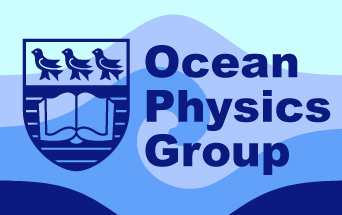In collaboration with colleagues at UVic and the Institute of Ocean Sciences, the Ocean Physics Group has a significant number of projects suitable for graduate students at the MSc or PhD levels. MSc projects involve either numerical modelling/theory or data analysis, PhD topics ideally will involve both.
Applying
I am jointly appointed in SEOS and Physics and Astronomy. Students have the option of applying through either department. The physics degrees require more physics courses to be taken, the SEOS degree more earth-system-science courses.
- Physics Grad Program: Calendar, Department
- SEOS Grad Program: Calendar, Department
While I want grad students, I strongly advise students to cast a wide net and discuss projects with other potential supervisors. There is a wide variety of approaches and methods and finding a good match for your personal tastes is important.
Applying for an NSERC is always a good idea, particularly if you are an A-student with research experience. Applications are usually due in early October, the year before you apply for grad school.
All students should apply to UVic by Feb 15th to be considered for a UVic award.
IOS Partner Projects:
Bill Williams
Circulation in the Western Arctic, and the effects of sea ice cover on biology in the Kitikmeot Sea.
Guoqi Han
Sea level and circulation variability off northern BC coast using ocean modelling and satellite altimetry.
Observational projects
These are opportunistic, in that when we can get ship time or participate in a project a data set is made available. Currently, I have datasets from:
- Surveys of the upper ocean from the CCGS Tully, aimed at understanding lateral turbulence statistics in the upper ocean (e.g. Klymak et al 2015, Callies and Ferrari, 2013) and comparing to SWOT altimetry; Likely collaborators: Tetjana Ross (DFO), Guoqi Han (DFO), Nicolas Grisouard (UofT).
- dye dispersal, and tidal dynamics, in Saanich Inlet. Likely collaborators: Eric Kunze, Patrick Cummins (DFO).
- Many observation and observation/model comparison projects possible with the https://cproof.uvic.ca data sets, both open ocean and coastal. See also the PRODIGY CREATE Likely collaborators depend a lot on the focus we decide on, but there is a lot of data here with many good projects!
Observational theses are less specified than numerical theses, as the ocean does not always yield observational results in a predictable manner. The steps are usually:
- characterize what phenomena are present in the observations
- quantify the phenomena
- understand what drives the phenomena
- attempt to parameterize the phenomena
where the last integrative step usually requires many observations and often benefits from theoretical and numerical insight.
Observational projects are challenging, but extremely rewarding.
Numerical Projects
I believe numerical process studies motivated by observations are a very powerful tool to improve our understanding of the ocean. Student projects are a little easier to specify in advance, and I do so here.
Eddy separation around headlands
Grad student Wendy Callendar found that the tides produce headland vortices around Cape St. James in the Queen Charlotte Islands. Interestingly, on certain tidal phases these eddies coalesced into larger mesoscale eddies that then spun off into the interior of the ocean. A project would be to idealize Wendy’s work and
- explore what tidal parameters set whether the eddies coalesce
- explore the propagation of eddy dipoles from the shelf to the deep ocean.
Effect of bottom-enhanced mixing on large-scale flows
Turbulent mixing impacts the strength of the global overturning circulation and the density stratification of the ocean. However, the turbulent mixing also depends on the stratification. So there is a potential climate feedback that has not been explored. The goal here would be to
- understand how a stratification-dependent dissipation should be entered into a simple model
- how the simple model responds to changes in atmospheric heat forcing
Ray tracing through non-canonical wavefields
In the open ocean, away from topography, the dominant way that turbulence is generated is via the somewhat random breaking internal waves. The problem is analogous to whitecapping on the sea surface, but without the wind’s direct forcing. Our understanding of the rate of this process is arrived at by tracing “test waves” through an empirical continuum of internal waves, modifying the waves until they are of a small enough scale to break. The continuum for these waves, however, often excludes well-known frequency peaks such as those driven by the tides. The question here is how does the ray tracing of the waves change as these peaks are made more prominent (if at all).
 UVic Ocean Physics
UVic Ocean Physics